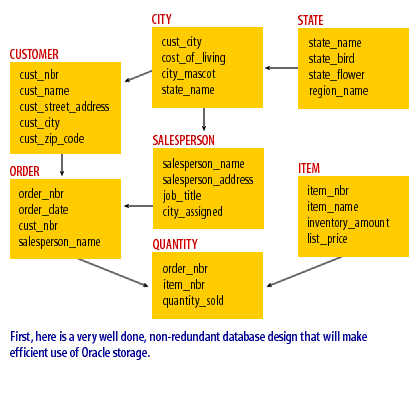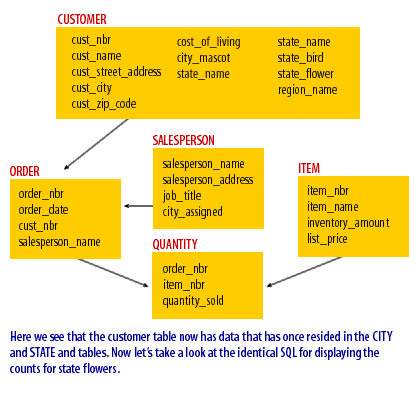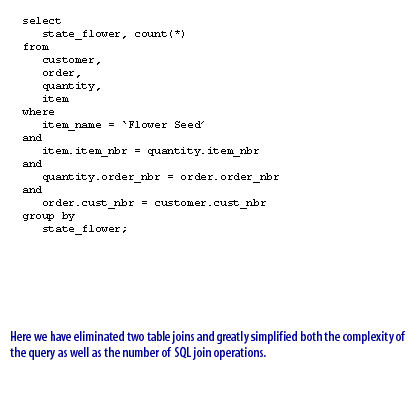Analyze Logical Database Design using Real-life example
| Lesson 5 | Implementing Logical Database Performance Design |
| Objective | Describe Characteristics of a High-Performing Database |
Analyze Logical Database Design Using a Real-Life Example
To illustrate how logical database design impacts performance, consider a database for managing product orders. Management wants to know the counts of "State flower" for all orders of "sunflower seeds." The output would look like this:
How Logical Database Design Impacts Performance
The logical design of a database significantly affects its performance by determining how data is organized and accessed. Key factors influencing performance include:
The following comparison illustrates how different database designs result in different SQL queries to achieve this output.
- Data Normalization: Normalization reduces redundancy and improves data integrity but can lead to complex queries and slower performance with large datasets.
- Indexing: Proper indexing speeds up data retrieval, while poor indexing can slow queries and increase storage needs.
- Joins: Combining data from multiple tables via joins can be resource-intensive, especially with many tables or large datasets.
- Data Types: Choosing appropriate data types optimizes performance; oversized types can slow queries and increase storage.
- Query Complexity: Complex queries with multiple joins or subqueries can degrade performance. Simplifying queries improves efficiency.
- Table Structure: Lean table designs with minimal columns and optimized row sizes enhance query performance and reduce storage.
State_flower count(*) ------------ -------- Begonia 433,233 Pansy 121,455 Tulip 44,233 Zenia 3,245
The following comparison illustrates how different database designs result in different SQL queries to achieve this output.

CUSTOMER Table
|
CITY Table
|
STATE Table
|
ORDER Table
|
SALESPERSON Table
|
ITEM Table
|
QUANTITY Table
|
SELECT s.state_flower, COUNT(*) FROM state s JOIN city c ON c.state_name = s.state_name JOIN customer cu ON cu.cust_city = c.cust_city JOIN "order" o ON o.cust_nbr = cu.cust_nbr JOIN quantity q ON q.order_nbr = o.order_nbr JOIN item i ON i.item_nbr = q.item_nbr WHERE i.item_name = 'Flower Seed' GROUP BY s.state_flower;

CUSTOMER
cust_nbrcust_namecust_street_addresscust_citycust_zip_codecost_of_livingcity_mascotstate_namestate_birdstate_flowerregion_name
ORDER
order_nbrorder_datecust_nbrsalesperson_name
SALESPERSON
salesperson_namesalesperson_addressjob_titlecity_assigned
ITEM
item_nbritem_nameinventory_amountlist_price
QUANTITY
order_nbritem_nbrquantity_sold

SELECT cu.state_flower, COUNT(*) FROM customer cu JOIN "order" o ON o.cust_nbr = cu.cust_nbr JOIN quantity q ON q.order_nbr = o.order_nbr JOIN item i ON i.item_nbr = q.item_nbr WHERE i.item_name = 'Flower Seed' GROUP BY cu.state_flower;This query eliminates two table joins (CITY and STATE), reducing complexity and improving performance by accessing the state_flower directly from the CUSTOMER table.
Data Warehouse Table Design
In data warehouses, "wide" tables with significant redundancy are common to optimize query performance. For example, combining all data from CUSTOMER, ORDER, SALESPERSON, ITEM, and QUANTITY into a single QUANTITY table creates a wide table. While updates become cumbersome, queries are faster because no joins are needed. A single-row fetch retrieves all order details, simplifying complex queries.
Physical Design Next
Having explored logical design, the next step is to examine how physical design impacts performance. By optimizing normalization, indexing, joins, data types, query complexity, and table structure, designers can create databases that handle large datasets efficiently.
Denormalizing Database - Exercise
Try redesigning a database to optimize performance with the exercise below.
Denormalizing Database - Exercise
Denormalizing Database - Exercise